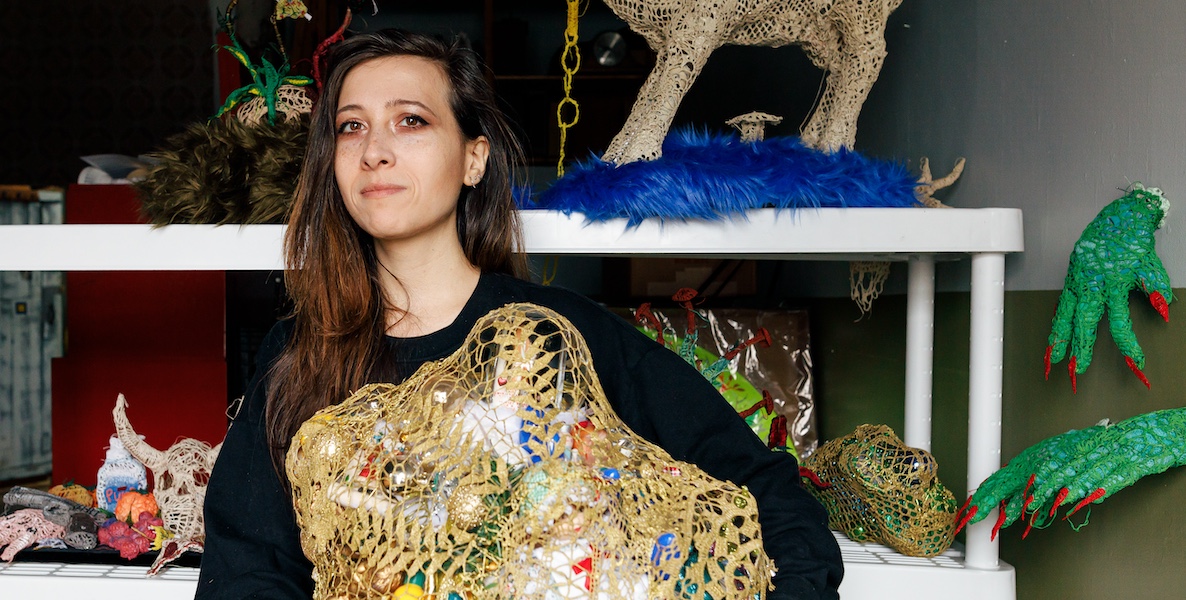If the word “crochet” conjures fond memories of grandma’s doilies, Cait McCormack’s twist on the technique could make you uncomfortable. McCormack, who grew up in a family of artists and crafters, crochets sculptures that challenge expectations of both fine art and craft traditions. McCormack is known for sculptures of death and decay, oblique references to unnamed traumas, and dark riffs on #GirlBoss decor, all meticulously constructed with traditional craft methods.
Shortly after graduating with an illustration degree from the University of the Arts, McCormack’s career took an unexpected turn with the rediscovery of their childhood hobby. Instead of hats or mittens, they began making intricate sculptures inspired by scientific displays of bird skeletons. Those garnered McCormack national recognition, with solo shows at galleries like Hashimoto Contemporary in San Francisco, CA.
Over time, McCormack expanded to building rodent skeletons, objects like VHS tapes and decorative pillows. Last year, McCormack exhibited at Fleisher Art Memorial as one of six winners of the 45th annual Wind Challenge, where their section was anchored by a mysterious life-sized figure covered in black velvet and crocheted plant life. Work from that same series was later described as “strangely wonderful” by The New York Times.
As part of a partnership with Forman Arts Initiative, the Citizen caught up with Cait McCormack. The interview has been condensed and edited for clarity.
RJ Rushmore: For me, the crochet brings to mind things like kids’ toys, misfit mittens, and half-finished scarves. Unseriousness, some might say. What attracted you to this particular medium?
Cait McCormack: I love crochet for its physicality. It’s an unbelievably diverse and super malleable modality. With crochet, I never have an issue generating an object to represent something in my head. Crochet is transformative, almost like alchemy, and it belongs to everyone. What’s unserious about that?
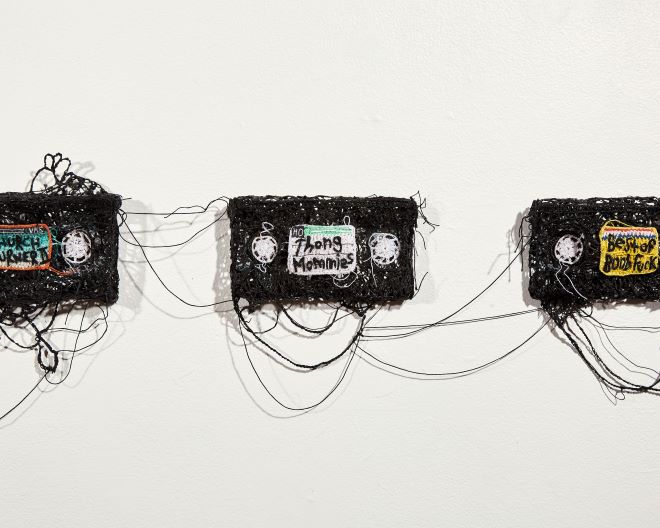
I operate in this liminal space between craft and fine art, and it’s difficult to navigate that territory. When I speak to curators, their eyes often fall to the ground because people don’t respect or legitimize crochet for sexist, ageist, classist and racist reasons. I encounter a lot of exhibitions that propose to “elevate” various crafts, which makes me very angry. Why enforce a separation? To elevate a craft is not really to embrace it, it’s just a way to justify selling something for $6,000 instead of $60. It’s becoming increasingly clear to me that a primary objective of my career is to uplift and acknowledge the various communities that utilize crochet, even if that makes art curators not quite sure what to do with me.
Would you disagree with the idea that, by making objects that can be macabre or sexually explicit and exhibiting them as fine art, you’re rebelling against the traditions of crochet?
Crochet is a diverse pool of many different hands and, because of that, it has the capacity to encompass imagery that is horny or terrifying, or both at once. I’m very excited and honored to be contributing to the conversation in my own way.
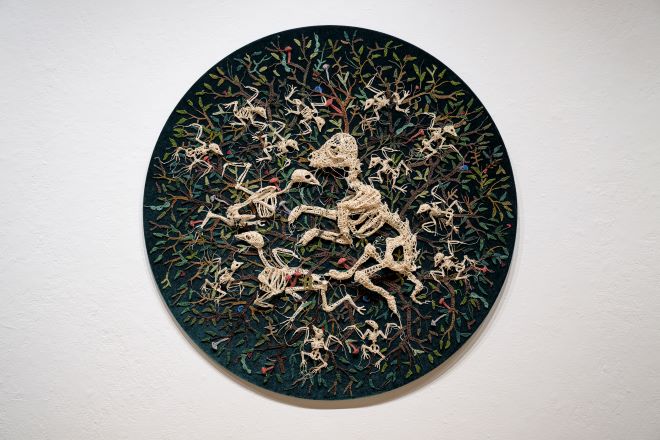
When did you first pick up crochet?
I grew up in a low-income household and made my own toys. My grandmother taught me to crochet and sew when I was about four. She would watch me like a hawk. She would spot a missed stitch and tell me to rip it up. I’d undo the whole thing and start over. It ingrained an element of perfectionism in me that borders on destructive, but I’m glad that I learned how to do things the right way.
But she wasn’t teaching you how to sculpt bird skeletons, I would assume.
That was inspired by my grandfather. He was a skilled woodworker and would carve and paint beautiful wooden birds. If he messed up a bird, it went in this thing called the “dead bird box.” Anything in that box was fair game for me to draw on with crayons.
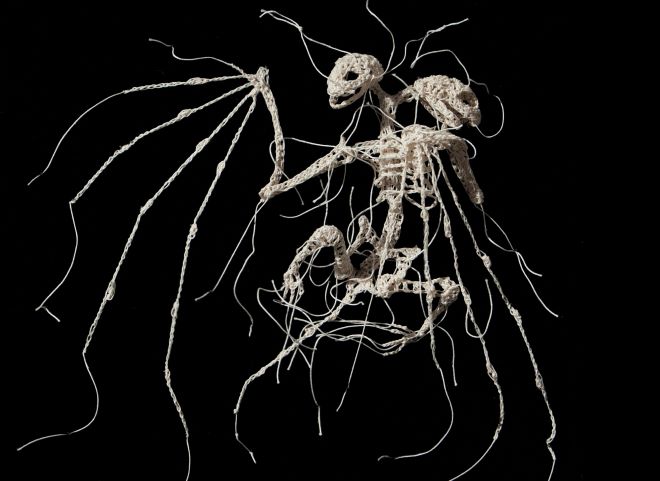
Shortly after I graduated from college, my grandparents passed away. My grandfather died first. My grandmother had dementia and would forget that he had passed away every 15 minutes, so someone had to constantly be at the house to remind her that her husband was gone. I started using her old crochet materials to generate amorphous blobs, to pass the time. I realized that the blobs looked a bit like bone tissue as viewed under a microscope, which led to making crochet bird skeletons as an homage to both of my grandparents.
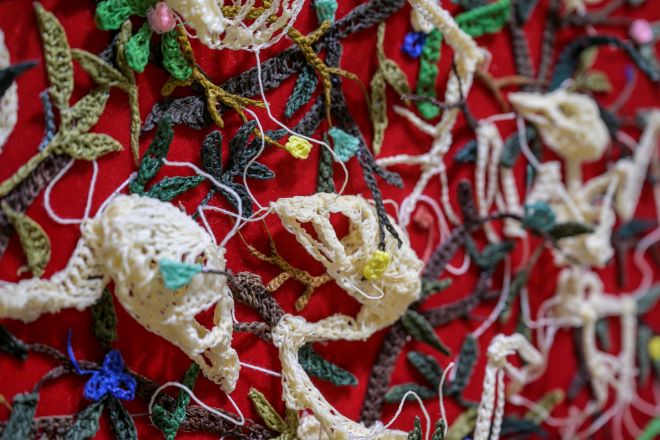
Those skeletons are how I was first introduced to your work. They’re very beautiful but also very dark. I had no idea the thoughtful story behind them.
With the earlier work, I was intentionally obfuscating, avoiding a clear translation. I’m a pretty traumatized individual, and I was trying to protect myself. Exhibiting art makes you incredibly vulnerable, and I don’t know if I was ready to expose myself. However, now I find it cathartic to make work that allows the viewer to draw a connection between object and meaning more rapidly.
Your newer work has a lot more humor to it.
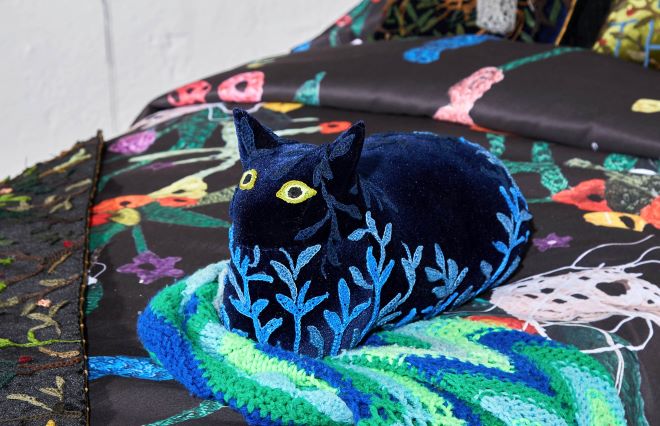
Humor is really important to me. It was challenging to communicate that with the binary color palette and melancholy of my older work. I started incorporating more colors and plant forms. When the pandemic reduced a lot of my relationships to text-based interactions, I gravitated toward text too. It became a way for me to integrate humor more directly. My dad, Brian, very recently passed away. He was a great artist and I’ve been thinking nonstop about all of the humor and creative problem-solving strategies he passed onto me, to contend with the grief.

Anyone who goes to a makers’ market today will come across cheeky hipster versions of “live, laugh, love.” Embroidery that says, “Per my last email” or “Nevertheless, she persisted.” Are you interested in those objects? Do you try to differentiate yourself from them? Text-centric pieces like your “Edging” blanket are fantastic, but they could also approach that line.
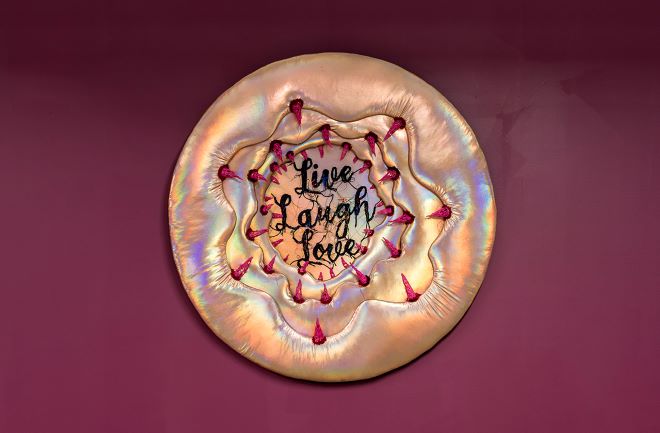
I am very interested in how people choose to represent themselves. The Millennial urge for a sassy “live, laugh, love” parody. The desire for a giant Stanley thermos. #Girlboss. I guess I choose to represent myself as someone who is intrigued and baffled by those aforementioned representations.
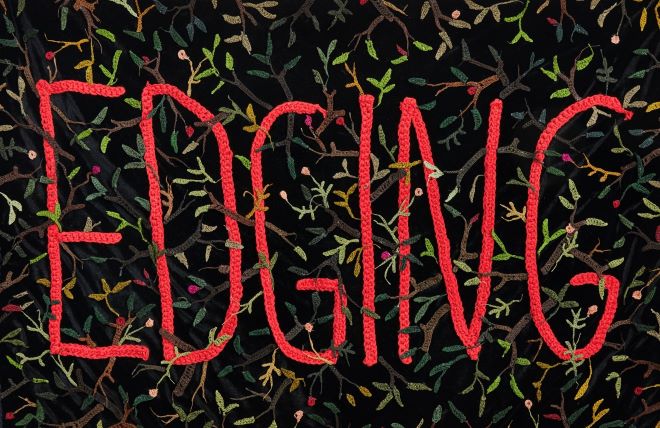
The “Edging” blanket came from re-entering society after being isolated during the pandemic. I felt like everything I did was so obscene. Even just glancing at someone, I was paranoid that it would be misinterpreted or have a dirty subtext. “Edging” came from my desire for a full-body shroud to cover every expression I might make because I wasn’t in control of how I could be perceived.
Where can people see your work now?
I’m in a three-person show at Partners and Son here in Philly, featuring sculptural works by me alongside graphic novel illustrations by J. Webster Sharp and Erik Svetoft. I also have a giant VHS tape in The New Salon, which recently opened at the Asheville Art Museum, and I’m working with Akeem K. Duncan of Quiet Lunch to develop a solo show at The Yard in Manhattan this fall.
RJ Rushmore is a writer, curator and public art advocate. He is the founder of the street art blog Vandalog and culture-jamming campaign Art in Ad Places. As a curator, he has collaborated with Poster House, Mural Arts Philadelphia, The L.I.S.A. Project NYC and Haverford College. Rushmore’s writing has appeared in Hyperallergic, Juxtapoz, Complex and numerous books. He holds a B.A. in Political Science from Haverford College, where his thesis investigated controversies in public art.

This story is part of a partnership between The Philadelphia Citizen and Forman Arts Initiative to highlight creatives in every neighborhood in Philadelphia. It will run on both The Citizen and FAI’s websites.
![]() MORE FROM OUR ART FOR CHANGE SERIES
MORE FROM OUR ART FOR CHANGE SERIES



